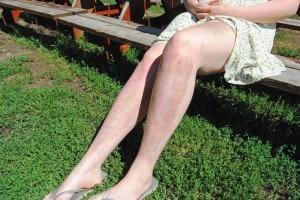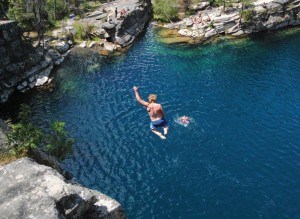
When Kat Cowie and her friends drove out to Horseshoe Lake, they were planning a fun and relaxing day in the sun, instead it ended with a trip to the hospital and a painful reminder about the dangers of cliff jumping.
Horseshoe Lake is a popular day-use area located about 30 km south of Jasper. It was Cowie’s second visit of the summer and her first cliff jump of the year.
The 19-year-old Ottawa native said she was accustomed to jumping off cliffs at her stepbrother’s cottage in rural Quebec, but had never jumped off an 80-foot cliff before.
“I walked up to the top and I watched another guy jump off,” she recalled. “Before he jumped, he told me a story about how he was up there for an hour and a half before he could jump off for the first time and he told me he was a little scared because the person who went before him got winded.”
Despite the warning, Cowie didn’t hesitate before making the running leap.
“You’re in the air for a few seconds so you have a moment to think and then I hit the water and everything went pretty fuzzy.
“I came up out of the water and I couldn’t breathe and someone yelled from the water if I was OK and I said ‘No.’
“The music stopped and this guy in a boat came and paddled towards me and I just held onto the side of the boat and he brought me to shore.”
Fortunately, two nurses, a doctor and a lifeguard happened to be nearby and were able assist her and help her catch her breath.
“They thought I had broken ribs,” said Cowie, who managed to walk to a car on her own.
Her friend drove her to the hospital where she was immediately sent for x-rays and checked for internal bleeding.
“They gave me a warm blanket and told me I could stay there for how ever long I wanted to and gave me a bit of a lecture about how dangerous Horseshoe was and how often they see people from Horseshoe.”
Five days after her jump, Cowie’s legs and forearms were still covered in bruises and she had missed nearly a week of work.
“I didn’t know it was as dangerous as it was,” she said. “I probably wouldn’t have done it if I had known how big an affect it would have had, because I’ve had to take time off work, it hurts to move and it hurts to sleep.”
Unfortunately, Cowie’s story isn’t unique.

In 2012, two people broke their backs after jumping off the same cliff. A year earlier, a man in his 20s died.
“You’ve got to land just right or else you can certainly injure yourself,” said Dr. Mark Addison, who splits his time between the Seton Healthcare Centre and the Cottage Medical Clinic.
“Over the years we’ve seen lots of injuries from there, the worst being drowning of course.”
He said the hospital has had to deal with fractured feet, broken ribs and broken vertebrae as a result of people landing wrong.
“Those are probably the more serious injuries that we do see,” he said, explaining alcohol doesn’t appear to be a major factor in the injuries he’s dealt with.
“Jumping from that sort of height you never know what could happen. I wouldn’t recommend it because every year we see many injuries that come from there, it’s not worth the risk.”
According to Parks Canada, there are at least three signs that warn visitors of the inherent dangers of cliff jumping as they walk from the parking lot towards the highest cliff area. There are no signs at the top of the 80-foot cliff.
“Information has been posted around the lake shore warning people of the dangers and the fact there have been injuries as a result of folks jumping off the cliffs,” said Rupert Wedgwood, manager of visitor safety for Parks.
“[Horseshoe Lake] is actually a really good place to practice diving from elevations that are no higher than a swimming pool diving board at your local recreation centre. The secret is you don’t go off the highest board when you haven’t been off the lowest, that’s a recipe for disaster,” he said.
Wedgwood blamed the issue on a number of factors, including peer pressure and alcohol use.
“There’s a certain amount of peer pressure, there’s a party atmosphere and it seems to be a really user-friendly place, so people tend to get carried away in the spirit of the moment.
“I think if people for one reason or another don’t have all their faculties about them, then they’re particularly susceptible to poor judgment and their coordination suffers.”
He said two people were recently arrested for drug use and open alcohol at Horseshoe Lake.
“I think in terms of the number of users that go there, the incidents are very small,” he said, explaining Parks responds to more incidents at Maligne Lake and often responds to calls for assistance at Pyramid Lake.
“These aren’t inherently dangerous places if people act responsibility,” he said, adding cell phone service in the area can be spotty and the closest pay phone is at Athabasca Falls.
Paul Schmidt, Jasper’s victim services coordinator, echoed Wedgwood’s thoughts.
“I think for the most part locals understand the risks that are involved,” he said.
“I think for someone who is walking in there and just looking to have a fun day and jumping in the water they may not realize how high that cliff is and they may not realize there is a rock outcrop and they need momentum to go off of it.
“It’s not that you can’t have fun there, but measure the risks when you’re doing it,” said Schmidt.
Had Cowie weighed those risks before jumping, she could have avoided a trip to the hospital.
“The consequences are way higher than I thought they were going to be,” she said.
Paul Clarke
[email protected]
